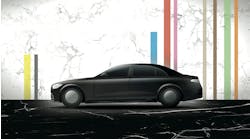THE WOODLANDS, Texas, Dec. 10, 2015—Time and time again, Ted Williams consults shops with out-of-control paint and materials costs. And according to a Mitchell report, it’s a nationwide trend: Paint and material costs have been rising steadily for years, increasing from $30.88 per refinish in Q4 2012 to $32.76 in Q4 2014.
Through visiting so many shops, Williams has been able to pinpoint the main problem.
“To cut down on paint and materials, people go towards generic clears and cheaper products,” Williams, a business consulting manager for Sherwin-Williams Automotive Finishes, said from the company's 2015 Vision Conference outside Houston on Thursday. “But they don’t realize the things that are impacting the cost of the product are the redos they're doing throughout the process. And then some of the product changes they’re making are actually slowing them down to get cars delivered.”
That’s why Williams and his fellow Sherwin-Williams consultants have to go beyond the paint department when helping shops eliminate internal redos. Williams sat down with FenderBender during a break in the conference on Thursday to discuss how savings in the paint department can come from reevaluating a shop’s refinishing stages, damage analysis, and parts checking process.
How would you define an internal redo?
It’s any time you have to touch something twice. Internal redos are things they catch before the car is actually delivered, so it’s different than a comeback. There’s time lost in that and you’re losing on labor. I’ll see an incorrect body repair that goes through the refinish department, and then somebody has to send it back and it takes additional priming to actually fix it. Primer is much more expensive than body primer.
It’s the little things that incrementally build up when it comes to waste in the paint department. You get paid to paint it once. The second time you paint it? You’re paying for it out of your own pocket. That’s why we put a big focus on productivity. For the average collision center, paint and material costs only make up 5 percent of their total sales—but labor is over 50 percent of sales. That’s why we put a huge focus on helping shops manage their materials on the cost side, because that’s where it kills you.
Where does the redo problem originate?
Most shops don’t understand that a lot of the issues that happen in the refinish department are being set up further upstream. It’s all about the completeness of your damage analysis when you look at the vehicle. During the teardown, they take the preliminary estimate, throw the car into production and expect the technician to take the car apart and then write a supplement sheet of all the additional things that need to be fixed.
The inherent flaw is we’re not involving the paint technician in any of that. So we miss processes or misidentify things that need to be done from a refinishing standpoint, and then the car doesn’t get to the paint technician for another three to four days. By that time, we’ve locked that estimate down to where we’re not going to do another supplement, so we don’t get reimbursed for any extra work.
I’ve been preaching that as part of your damage analysis, actually bring the painter up there during the process and verify color for the car. So if parts come in, you can paint parts off cars because you’ve already got your color chosen. Have the painter actually look at the repair order and make sure it accurately reflects what we’ve got to do to the car. Do we need to de-trim this panel? Can we blend this panel? Have them actually actually look at that and map out the repair so everybody during the repair process knows what’s happening.
Does the parts department play a role in reducing paint and materials costs?
When parts come in, we actually need to mirror-match the parts, put them side-by-side to each other. That way, we either know it’s the correct part, or we can say, “No, these aren’t the same—one is longer than the other. This is not the correct part.” All too often we don’t even unbox the part until we start putting the car back together. We get bumper covers in and we send it to the paint department and expect them to paint it, but we don’t even know if we’ve got the right part that we’re painting.
Take a common vehicle, like a Toyota Camry. A shop may have three or four of those cars in their shop at any given time. How is a painter supposed to know that the bumper cover you sent back there to them was for a particular car unless you mark that part with a repair order number? I see people who send a bumper back there with no designation for which vehicle it’s for. I suggest using a price label gun and having them write the repair order number on a sticker and sticking it on the back side of the panel.



